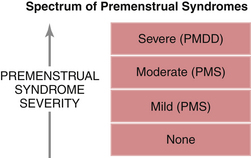Chapter 36 Menstrual Cycle–Influenced Disorders∗
The human menstrual cycle is unique as a physiologic process in that it involves mechanisms that change on a daily basis rather than remaining stable. This process of change is carried out through the many intricate hormonal interactions between the hypothalamic region of the brain, the pituitary gland, the ovaries, and to some extent, the adrenal glands and the pancreatic islets of Langerhans (see Chapter 4). To a large degree, the subject matter of reproductive endocrinology deals with disturbances of this interglandular hormonal communication that may result in irregular or absent menstrual cycles.
 Premenstrual Syndrome and Premenstrual Dysphoric Disorder
Premenstrual Syndrome and Premenstrual Dysphoric Disorder
The acronyms PMS for premenstrual syndrome and PMDD for premenstrual dysphoric disorder refer to the same pathologic process at opposite ends of the symptom spectrum (Figure 36-1). In both PMS and PMDD, patients experience adverse physical, psychological, and behavioral symptoms during the luteal phase of the menstrual cycle. There is a crescendo of symptom intensity up to the time that menses begins, with quick resolution thereafter. Some patients have a brief surge of symptoms at the time of ovulation in midcycle.

FIGURE 36-1 Spectrum of premenstrual syndromes. PMDD, premenstrual dysphoric disorder; PMS, premenstrual syndrome.
A formal set of diagnostic criteria has been proposed in the fourth text revision of the Diagnostic and Statistical Manual of Mental Disorders (DSM-IV) of the American Psychiatric Association for PMDD (Table 36-1). Although the DSM-IV definition of PMDD specifies that this is not just an exacerbation of another disorder, the dividing line between PMDD and other neuropsychiatric disorders is not so clear cut. For example, 46% of PMDD patients have a history of a prior major depressive episode. Moreover, patients with PMDD and clinical depression share similar sleep electroencephalogram alterations, and they are both responsive to the selective serotonin reuptake inhibitor (SSRI) antidepressants.
TABLE 36-1 CRITERIA FOR PREMENSTRUAL DYSPHORIC DISORDER
Stay updated, free articles. Join our Telegram channel

Full access? Get Clinical Tree


